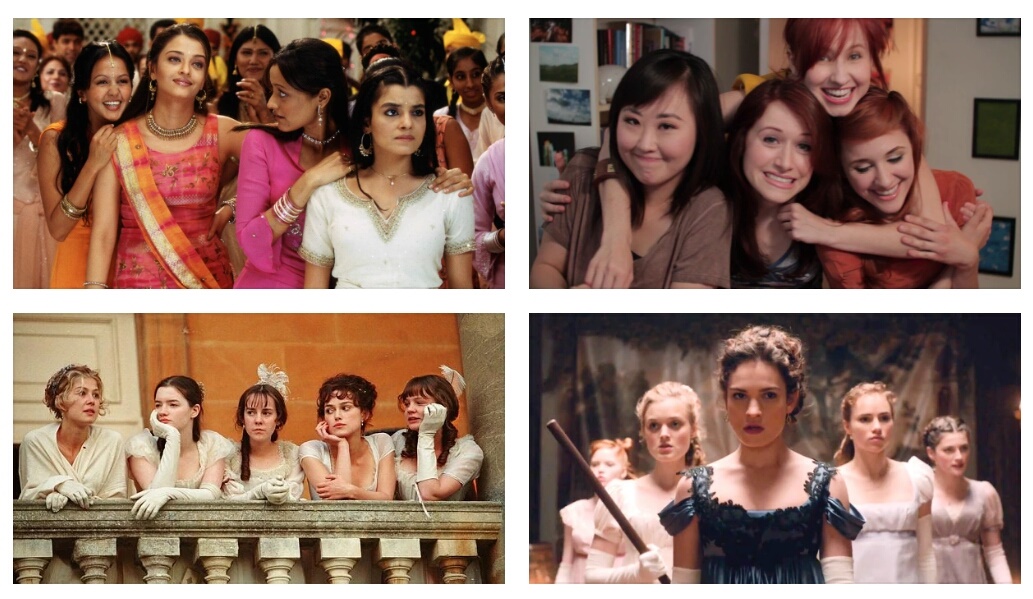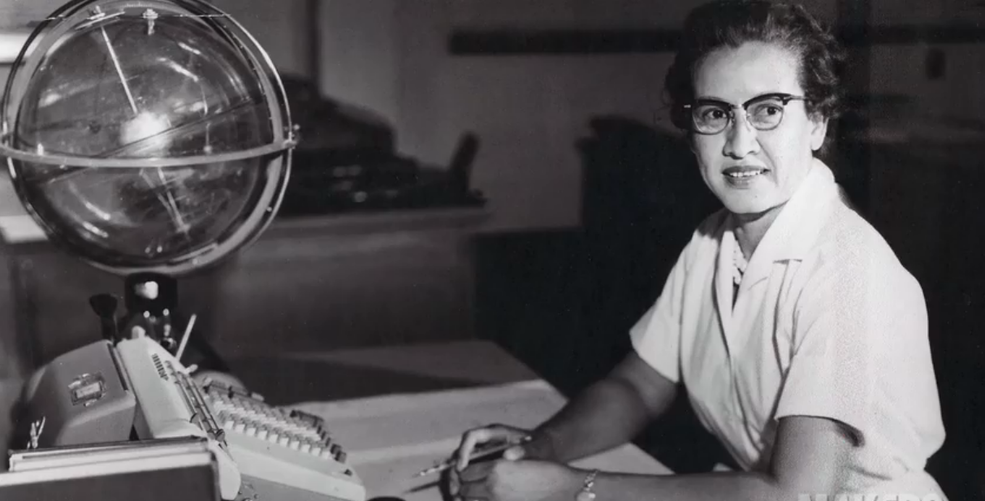This guest post written by Maddie Webb appears as part of our theme week on Sisterhood.
The Bennet sisters are some of the most enduring characters in fiction and Pride and Prejudice remains a beloved story. Can the modern incarnations of Lizzie, Jane, Lydia, Kitty, and Mary explain why people keep falling in love with their story?
Pride and Prejudice, for most people in popular culture, is seen as an early example of the “rom-com” genre. Boy meets girl, boy and girl hate each other, but despite their clashing personalities, they grow, develop and eventually, inevitably, fall in love. But Pride and Prejudice is more than just a first in its genre; it’s also one of the most adapted, readapted, spun off, and reworked pieces of fiction. I think the reason for that isn’t about how hunky Darcy and Wickham are or even the comic stylings of Mrs Bennet; I think it’s because of the Bennet sisters.
Like most of Jane Austen’s work, there is so much more going on under the surface and it’s easy to miss how her plots or characters often subvert societal norms, which is part of the reason her stories endure. In the case of Pride and Prejudice, this subversion comes in the form of the Bennet sisters, who are at once relatable and thoroughly atypical female characters in Regency fiction. Even within the confines of the 19th century, the Bennet sisters, for better and worse, have agency and personality coming out their ears. Though I didn’t watch every single adaptation of Austen’s classic (you’ll have to forgive me but my spare time is not that abundant), the most successful ones choose to make Lizzie’s happiness as dependent on her relationship with her sisters as her relationship with Darcy.
Three modern versions of Pride and Prejudice I did watch recently are Bride and Prejudice, the web series The Lizzie Bennet Diaries and Pride and Prejudice and Zombies — all of which I can recommend for different reasons, but all ground the heart of the narrative in the Bennet sisters’ bond. My personal favorite retelling of the Elizabeth Bennet story is The Lizzie Bennet Diaries, an Emmy-winning web series that reimagines Lizzie as a grad student who starts a video series while studying mass communication. Although only two of the sisters, Jane and Lydia, make the cut for this adaptation (there is a cousin Mary and a cat replaces Kitty), they are unquestionably more important to Lizzie than her love life, a good thing considering Darcy doesn’t even appear in person until episode 50. The vlogging format of the show gives the story enough room to fully flesh out both Jane and Lydia and shifts large amounts of Lizzie’s character development onto her relationships with her sisters. Lydia even gets her own spin-off series, which in her own words is “totes adorbs.”
I also enjoy Bride and Prejudice, the 2004 Bollywood film, mostly because of some killer musical numbers, but also because of the Bakshi sisters’ camaraderie. Our Elizabeth character, here called Lalita Bakshi, has three sisters, only losing Kitty in the translation (poor Kitty). Having the concept of arranged marriages still in place within the culture makes it a modernization that maintains more of the plot than The Lizzie Bennet Diaries. But again the alterations made to the story are largely to do with the sisters. The frame of the plot is largely the same, but the chemistry, affection, and bickering between the women feels honest and refreshing; it’s given more screen-time than the period adaptations. Bollywood and Regency fiction may not seem like a natural pairing, but keeping the family dynamic central is key to why this version is so charming.
Pride and Prejudice and Zombies may be ridiculous but it’s both a period film and an action movie, making it my kind of ridiculous. Even though this is still technically a period piece it has much in common with the other modern spins on the story. The action in Pride and Prejudice and Zombies is focused on the power of the sisters as a team and helps develop their characters. The opening fight scene — when the girls slaughter the zombie hoards — is a moment where an otherwise muddled film comes alive, while the training scenes are used to smuggle in some sister bonding time, over their love lives. Considering how easily this could have ended up as the period version of Sucker Punch, the Bennet sisters ensure that the film, while occasionally brainless, is never heartless.
Another key point of change in these versions is how the Wickham/Lydia plot is handled. I can only speak for myself, but in the book, Lydia’s behavior for me is just another annoying inconvenience in the path of Lizzie and Darcy’s happiness. In the original, the issue of Lydia running off isn’t about what will happen when Wickham abandons her, but more that it’ll ruin the family’s standing in society (read: Lizzie and Jane, the characters we actually care about). However, placed in a modern context, the Wickham/Lydia plot reads more like an abuse story. She is still young, naïve, and silly but crucially, not vilified because of it. As a result of this subtle but important distinction, Wickham is elevated from cad to full on monster. Hell, in Pride and Prejudice and Zombies, he literally locks Lydia up and is unmasked as the cause of the zombie apocalypse. It’s another element of this version that is a bit ridiculous, but again, no one can accuse Pride and Prejudice and Zombies of being subtle.
The Lizzie Bennet Diaries variation on Wickham, while more restrained, is equally as menacing and monstrous. Over the course of the series, a subplot of party girl Lydia becoming isolated from her family slowly unravels. Now career women, Jane and Lizzie are too busy for their little sister, with the latter dismissing her as a “stupid whorey slut” in the second episode. This leads her to be emotionally manipulated by Wickham, which we get to see painfully play out in her own spin-off series. The episode in which Lizzie confronts her and Lydia realizes Wickham’s true nature, is devastating. Not because it messes with Lizzie’s happiness, but because we truly care about Lydia. Creators Hank Green and Bernie Su have spoken at length about the importance of their alterations to Lydia’s story, resulting in a heartbreaking and insightful portrayal of abuse, within a light comedy series.
A similar situation unfolds in Bride and Prejudice, perhaps to a more satisfying conclusion since we get to see both Bakshi girls slap Wickham before walking out hand in hand. It’s only fitting that, in each of these adaptations Lydia is (sometimes literally) saved from Wickham and her crime of being an impressionable and impulsive teenage girl is no longer worth a life sentence. This area of the story has always left a bad taste in my mouth when it comes to the otherwise completely serviceable 2005 Joe Wright film adaptation. Despite bringing a modern filmmaking sensibility to the rest of the narrative, Lydia is still just another silly, inconvenient hurdle on Lizzie’s path to happiness, a real wasted opportunity to show how crap it was being a woman in Regency England.
People love Pride and Prejudice for all sorts of reasons: for example, my mother is rather attached to Colin Firth’s Darcy. But more and more it seems you can judge the quality of modern adaptations on how the filmmakers view Lizzie in relation to her sisters. Even though the representation of women has greatly expanded since Austen’s time, a story that revolves mostly around sisterly relationships remains rare, which makes it even more vital. And while it is true that Austen’s romance has a timeless quality that makes it popular, the narrative of sisterly love remains transcendent.
See also at Bitch Flicks: How BBC’s ‘Pride and Prejudice’ Illustrates Why The Regency Period Sucked For Women; Comparing Two Versions of ‘Pride and Prejudice’; “We’re Not So Different”: Tradition, Culture, and Falling in Love in ‘Bride & Prejudice’; 5 Reasons You Should Be Watching ‘The Lizzie Bennet Diaries’
Recommended Reading: Lizzie Bennett Diaries #2 by Hank Green (on the Lydia Bennet story)
Maddie Webb is a student currently studying Biology in London. If she doesn’t end up becoming a mad scientist, her goal is to write about science and the ladies kicking ass in STEM fields. In the meantime, you can find her on Twitter at @maddiefallsover.














